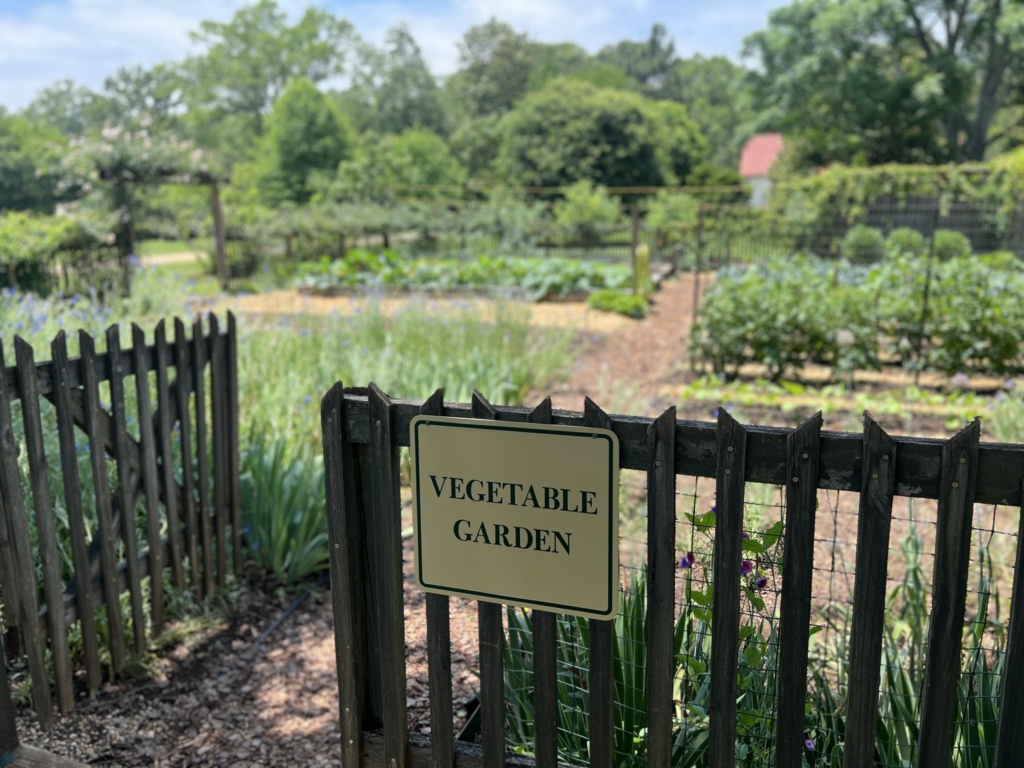The (Vegetable) Garden of Memories

Right now is the time to think about your next vegetable garden, because in my opinion, fall is the best season for a novice gardener to experience the most success and satisfaction with growing vegetables. Generally speaking, disease and pest pressures are lower and, while you do need to start those veggies when it’s still hot, you can actually enjoy working in the garden as the temperatures gradually lower. Typically, cool season crops will grow well into January or February, supplying your friends and family with a plethora of tasty edibles.
Here at Hills & Dales Estate, we have a long legacy of growing food crops in the garden. According to an article written by Barbara Madison Tunnell in 1920 entitled “The Garden of Memories,” she described trees “supplying an abundance of fruit and nuts” planted on the terraces. Her list noted pear, peach, Japanese and native plums, figs, apricots, cherries, Japanese persimmons, pecans, walnuts, and chestnuts, along with grapes and scuppernongs. We also know there were pomegranate, peach, and pear trees growing near the sunken garden in earlier times. While many of these are no longer extant in their previous locations, due to the natural ebb and flow of a garden and how spaces change over time, the horticulture staff has been working to incorporate more food crops into the garden landscape as a tribute to those who have tended this property in the past. That, and because it’s fun!
Throughout the estate’s history, the designated area for the vegetable garden has been in several different locations. In the late 20th century, it was located where the cutting garden is now, near the drive border and the greenhouse. This location was later abandoned for vegetable growing, due to the buildup of root knot nematodes in the soil. While there are some nematodes that are beneficial, this particular type invades the roots of crops, especially tomatoes and carrots, where they negatively impact the plant’s health and ultimately its vigor. This is one reason why rotating crops within a garden space is important. By rotating crops of various families, you can prevent the numbers of harmful nematode species from proliferating. When I came to work here in January, I found the latest space was located within a small picket fence west of the historic greenhouse, and mixed with beautiful climbing roses, peonies, and iris. Personally, I’ve always loved the idea of combining flowers and vegetables together and quickly decided this would be the best place to continue and revitalize what had already been started. My goal in this project wasn’t to reproduce the 9-acre organic farm I previously managed, but to take those same principles and scale them down to what could be done in someone’s backyard. I wanted to provide an example to our guests, giving them a vision of what a home vegetable garden could look like.
I’m proud of what we have accomplished already in this space and have found joy watching the children and grandchildren of our volunteers and staff pull fresh carrots out of the earth. Immediately, smiles cross their faces as they see this bright root crop emerge, and the smell of carrots and fresh garden soil permeates the air. Another staff member spoke of how her daughter loved watching her cut the beets on their cutting board at home because it stained the board red. I’ve always enjoyed observing how gardens can bridge the gap between all ages, connecting us through the power of growing food, and I hope this has convinced you to give vegetable gardening a try this fall.
Here are some tips for success:
• Crops: Fall is for cool season vegetables. These are things like broccoli, cauliflower, cabbage, collards, kale, turnips, beets, lettuce, spinach, garlic, onions, carrots, radishes, etc.
• Timing: Plant most of these in the last week of August or the first week of September. You need to get them established while it’s still warm and we have longer days so they will reach maturity before the days start getting shorter in October.
• Pests: Keep an eye out for cabbage loopers. These are caterpillars that love to eat the foliage on all the brassicas (broccoli, cabbage, collards, kale, etc.). If you see moths landing on your crops, they are laying eggs. Check the back of the leaves for orange or yellow egg masses and remove them. Also check for tiny green caterpillars. Spraying Bt (Bacillus thuringiensis), a bacterium that targets caterpillars, will help kill them. This remedy is often used in organic and even conventional production.
• Season Extension: Many fall crops can be held over into winter (particularly mild ones) if they have reached maturity and are covered using wire hoops and frost protection fabric. Generally, cover crops when the temperature is 32°F or lower.
Consider the possibilities for what vegetable gardening can look like at your home in the coming months. Is it a barrel that you sprinkle lettuce seeds in, outside your kitchen door and easy to harvest? Is it raised beds or containers in your backyard? Or is it like ours, using a mix of raised beds and the existing soil? As you visit the estate this fall and winter, I hope to hear of your own experience and how it has brought you, your family, and your community closer together.
Happy gardening! ~JB
 |
 |
View this entire Portico Newsletter: